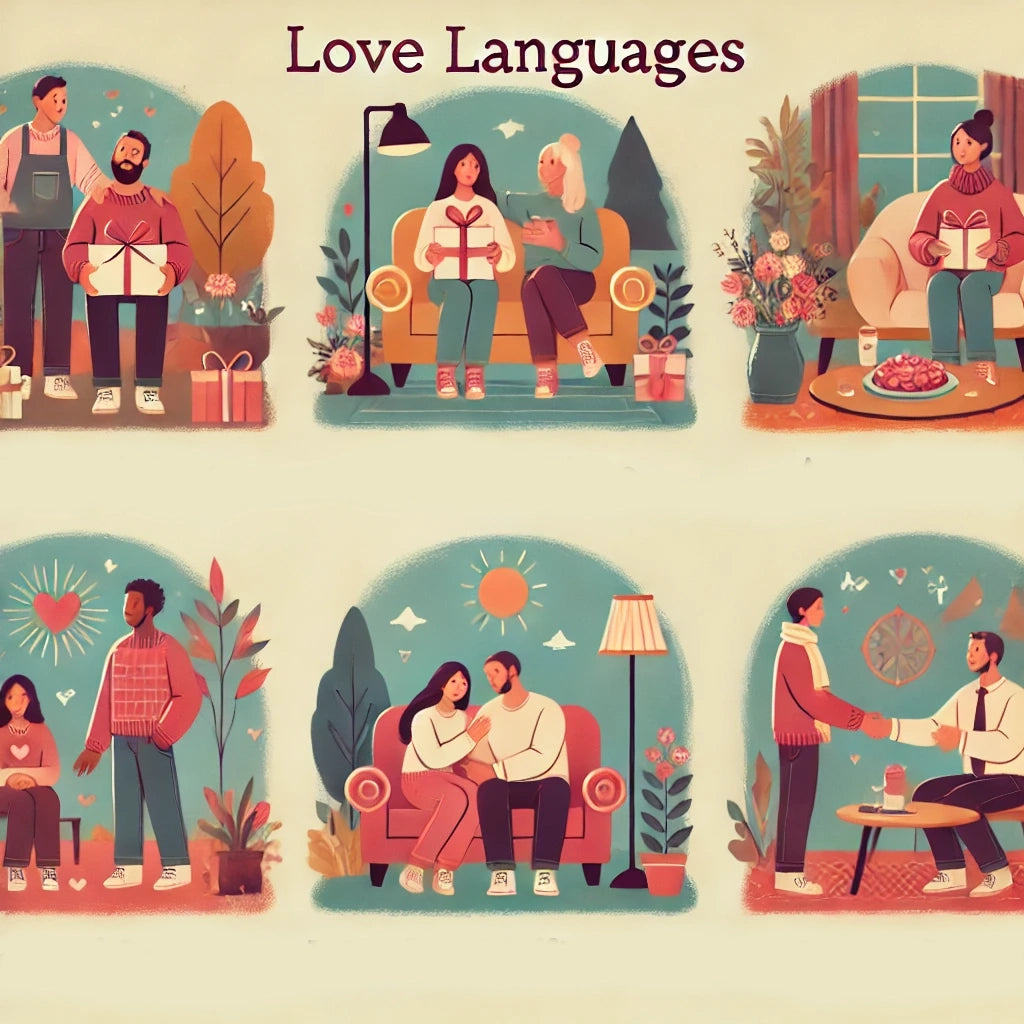
Understanding Love Languages: A Guide to Deepening Relationships
Love is a complex and multifaceted emotion that binds people together in various forms of relationships. Whether romantic, familial, or platonic, love requires communication, understanding, and effort to thrive. One of the most effective ways to foster and strengthen these bonds is through the concept of love languages. Coined by Dr. Gary Chapman in his book "The 5 Love Languages: The Secret to Love That Lasts," the idea of love languages has become a widely accepted framework for understanding how people express and receive love.
The Five Love Languages
Dr. Chapman identifies five primary love languages: Words of Affirmation, Acts of Service, Receiving Gifts, Quality Time, and Physical Touch. Each language represents a different way that people communicate and perceive love. Understanding these languages can help individuals better connect with their partners, family members, and friends.
1. Words of Affirmation
Words of Affirmation involve expressing love and appreciation through verbal communication. This can include compliments, encouraging words, and affirmations of love and support. For individuals whose primary love language is Words of Affirmation, hearing kind and positive words can make them feel valued and loved.
Examples:
-
Complimenting your partner on their appearance or achievements.
-
Sending a thoughtful text message to a friend, expressing gratitude for their presence in your life.
-
Telling a family member how much you appreciate their efforts and support.
For those who resonate with this love language, words carry significant weight. Criticism or negative comments can be particularly damaging, as they may feel a heightened sensitivity to spoken words.
2. Acts of Service
Acts of Service involve showing love through actions rather than words. This can include doing chores, running errands, or helping with tasks that ease the burden on the other person. For people who value Acts of Service, actions often speak louder than words.
Examples:
-
Cooking a meal for your partner after a long day.
-
Helping a friend move or complete a project.
-
Taking care of household chores without being asked.
Those who prioritize Acts of Service feel loved and appreciated when others take the time to do something meaningful for them. Conversely, broken promises or laziness can be particularly hurtful, as they may perceive it as a lack of care or effort.
3. Receiving Gifts
Receiving Gifts involves expressing love through tangible items. These gifts do not have to be extravagant or expensive; rather, they should be thoughtful and meaningful. For individuals whose love language is Receiving Gifts, the physical act of receiving a gift symbolizes love and affection.
Examples:
-
Giving your partner a small, thoughtful gift to show you were thinking of them.
-
Bringing a friend their favorite snack as a surprise.
-
Sending flowers to a family member to brighten their day.
It's important to note that the significance of the gift lies in the thought and effort behind it, rather than its monetary value. Forgetting special occasions or giving thoughtless gifts can be particularly hurtful to those who value this love language.
4. Quality Time
Quality Time involves giving someone your undivided attention. This means engaging in meaningful activities together, having deep conversations, and being fully present in the moment. For individuals who value Quality Time, shared experiences and focused attention are key to feeling loved and connected.
Examples:
-
Planning a date night with your partner where you focus solely on each other.
-
Having a heart-to-heart conversation with a friend without distractions.
-
Spending time with family members doing activities that everyone enjoys.
Those who prioritize Quality Time feel most loved when others make an effort to spend time with them. Distractions, postponed plans, or a lack of presence can be particularly hurtful.
5. Physical Touch
Physical Touch involves expressing love through physical contact. This can include hugs, kisses, holding hands, or any other form of physical affection. For individuals whose love language is Physical Touch, physical closeness and touch are essential to feeling loved and secure.
Examples:
-
Hugging your partner or holding their hand.
-
Giving a friend a comforting pat on the back or a warm embrace.
-
Cuddling with a family member while watching a movie.
For those who value Physical Touch, affectionate gestures are powerful expressions of love. Physical neglect or a lack of touch can be particularly painful and can lead to feelings of isolation and distance.
Applying Love Languages in Relationships
Understanding love languages can transform how we interact with our loved ones. By identifying and speaking each other's love languages, we can build deeper, more meaningful connections. Here are some practical steps to apply love languages in your relationships:
1. Identify Your Love Language and That of Others
The first step is to identify your own love language and the love languages of those around you. This can be done through self-reflection, conversations, and even taking online quizzes based on Dr. Chapman's framework. Understanding each other's love languages can provide valuable insights into how to express and receive love more effectively.
2. Communicate Openly
Once you know your love languages, communicate openly with your loved ones about what makes you feel valued and loved. Encourage them to do the same. This dialogue can foster mutual understanding and appreciation, helping to prevent misunderstandings and unmet needs.
3. Make a Conscious Effort
Make a conscious effort to speak your loved one's love language regularly. This might require stepping out of your comfort zone or changing your usual habits, but the effort will be worthwhile. Consistently expressing love in a way that resonates with your partner, family member, or friend can strengthen your bond and enhance your relationship.
4. Be Patient and Understanding
Learning to speak a new love language can take time and practice. Be patient with yourself and others as you navigate this process. Understand that everyone expresses and perceives love differently, and it may take some trial and error to find what works best.
5. Show Appreciation
Show appreciation for the efforts made by your loved ones to speak your love language. Recognize and acknowledge their gestures, even if they aren't perfect. Positive reinforcement can encourage continued efforts and deepen your connection.
The Impact of Love Languages on Various Relationships
Love languages are not limited to romantic relationships; they can also have a profound impact on familial and platonic relationships. Understanding and applying love languages in different contexts can improve communication, foster empathy, and create stronger, more supportive bonds.
Romantic Relationships
In romantic relationships, understanding and speaking your partner's love language can lead to greater intimacy and satisfaction. It can help you navigate conflicts, meet each other's needs, and build a lasting connection. For example, if your partner's love language is Quality Time, prioritizing regular date nights or shared activities can enhance your relationship.
Family Relationships
In family relationships, love languages can improve communication and understanding between parents and children, siblings, and extended family members. Recognizing each family member's love language can help create a more harmonious and supportive family dynamic. For instance, if a child's love language is Words of Affirmation, regularly offering praise and encouragement can boost their self-esteem and strengthen your bond.
Friendships
In friendships, understanding love languages can deepen your connection and make your friends feel valued and appreciated. By recognizing and speaking your friends' love languages, you can offer more meaningful support and strengthen your friendship. For example, if a friend's love language is Acts of Service, offering to help them with a task or project can show your care and support.
Challenges and Considerations
While the concept of love languages is a powerful tool for enhancing relationships, it's important to recognize that it is not a one-size-fits-all solution. People are complex, and their expressions and perceptions of love can be influenced by various factors, including cultural background, personal experiences, and individual preferences. Here are some challenges and considerations to keep in mind:
Cultural Differences
Cultural differences can impact how love languages are expressed and perceived. What might be considered a loving gesture in one culture could be interpreted differently in another. It's important to be mindful of cultural nuances and to communicate openly with your loved ones about what makes them feel valued and loved.
Individual Preferences
While the five love languages provide a helpful framework, individuals may have unique preferences and needs that don't fit neatly into one category. It's essential to remain flexible and open to understanding the specific ways your loved ones express and receive love.
Changing Needs
People's love languages can evolve over time, depending on their life circumstances, personal growth, and relationship dynamics. Regularly checking in with your loved ones and adapting to their changing needs can help maintain a strong and loving connection.
Balancing Multiple Love Languages
Many people have a combination of love languages, with one or two being more dominant. Balancing multiple love languages within a relationship can be challenging but also rewarding. Being attentive to your loved ones' various needs and making a conscious effort to address them can enhance your relationship.
Conclusion
Love languages offer a valuable framework for understanding and deepening our relationships. By recognizing and speaking each other's love languages, we can foster greater intimacy, trust, and connection with our partners, family members, and friends. While there may be challenges and complexities along the way, the effort to understand and express love in meaningful ways is a worthwhile investment in the health and happiness of our relationships.
As you embark on the journey of exploring love languages, remember that love is a dynamic and evolving emotion. Stay open, patient, and committed to learning and growing with your loved ones. By doing so, you can create lasting bonds that bring joy, fulfillment, and a sense of belonging to all areas of your life.
xoxoxo
-The Not So Common Gal
